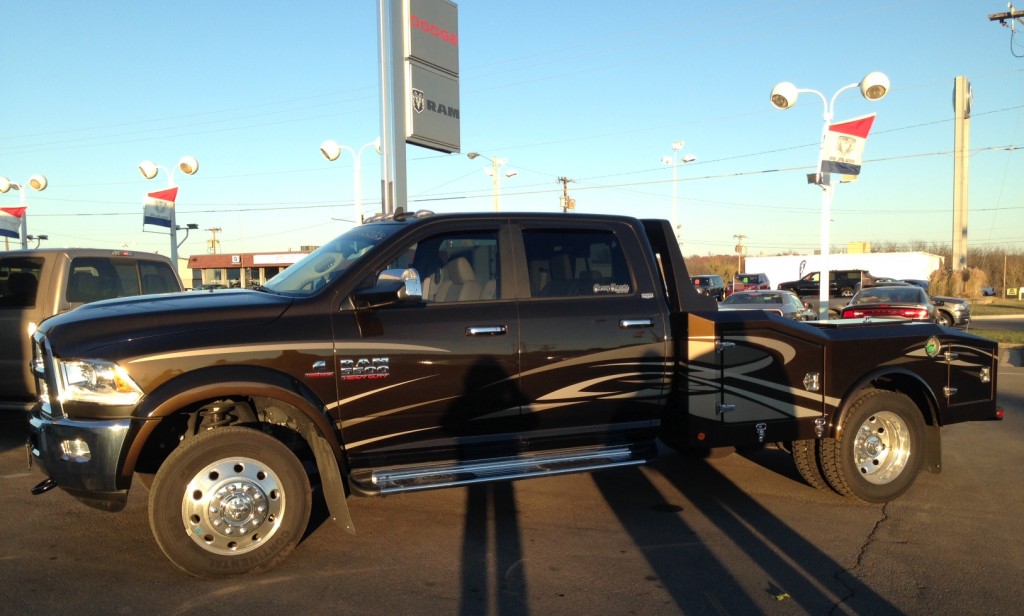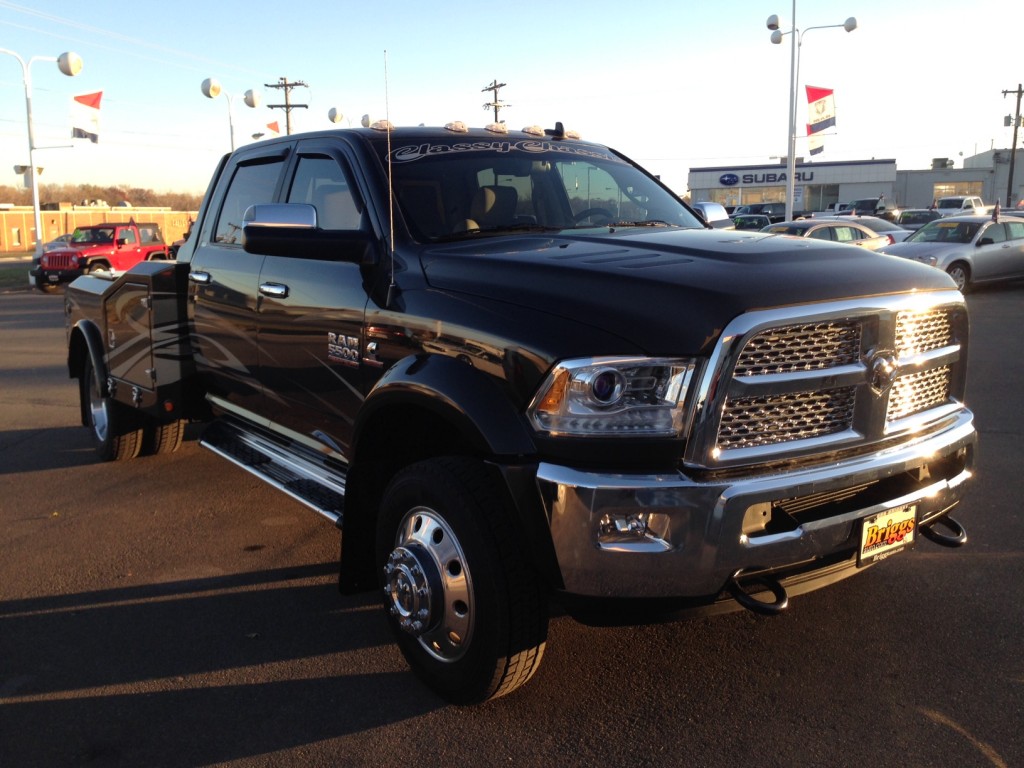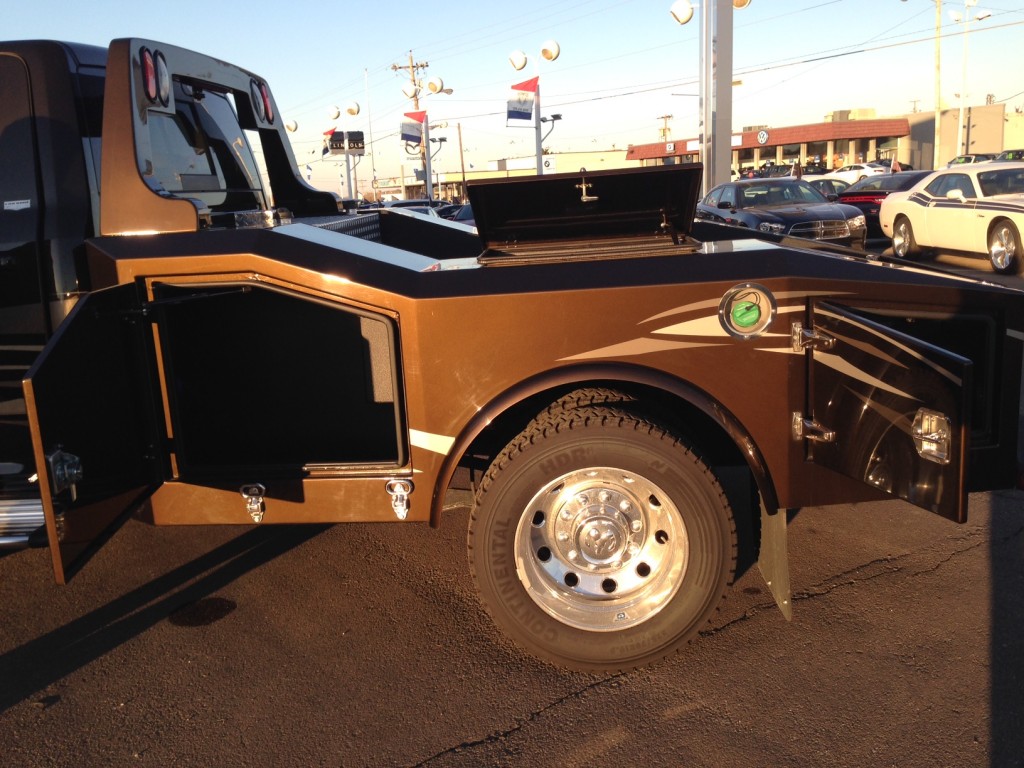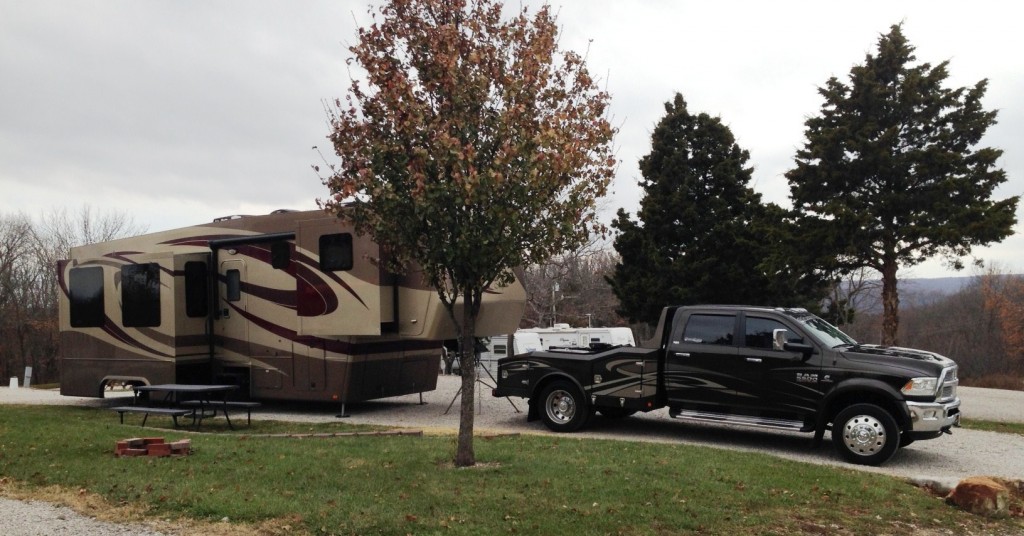As I mentioned in my post about RVers Boot Camp, we had our rig weighed using the Smart Weigh system and found that our RV had too much pin weight for the rear axles of the F450. When we bought the F450 we were told it could pull any 5th Wheel we bought and people had repeatedly told us that the F450 was plenty of truck. Well, it was and it wasn’t. The towing capacity was fine, but our New Horizons RV was just too heavy up front. No matter how we rearranged our stuff (we have 1,400 lbs of belongings on board which is light for full-timers) we would have still had too much weight up front. So, while we were in Kansas we bought an even bigger truck: a Dodge Ram 5500 (equivalent to the Ford F650). It is the most power you can get in a truck without going to a Heavy Duty Truck (semi).
In order to understand why we needed an even bigger truck, you need to know some special towing terms. First, there are terms that relate to the truck:
The Gross Vehicle Weight Rating (GVWR) is the maximum amount the truck can weigh – the truck itself, what you have in the truck – including the passengers – plus the payload.
The Gross Axle Weight Rating (GAWR) is the amount you can have on the axles of the truck, so there is a Front GAWR and a Back GAWR.
The Gross Combined Weight Rating (GCWR) is the maximum amount the truck can pull and carry – the GVWR plus the weight of the trailer.
There are similar ratings for the trailer – in our case a 5th wheel.
Our New Horizons 5th Wheel is designed for full-timers, which means that it has extra weight and features that can stand up to people living in it full-time. It has extra insulation, four slide-outs, extra large tanks, two furnaces, two air-conditioners, extra batteries, solar panels, and the polar package that helps keep the pipes and tanks from freezing. We have two axles and each has an 8,000 pound GAWR. With a 5th wheel, you expect 20% of the weight to rest on the truck – on the hitching pin. When we weighed the 5th Wheel by itself including our possessions, our axles were fine with 7,200 pounds on one and 7,120 pounds on the other. More than 10% under the GAWR for each axle. The pin weight, however, was 5,150 pounds. You might notice that this is more than the 20% that should be on the pin (4,000 pounds).
After the weighing, we went over the figures to see what the F450 was rated. The Rear GAWR for the F450 was 9,000 pounds but, because of the extra pin weight, we had 9,600 pounds on it. Also, the GVWR (truck and what it is carrying) was rated at 13,300 pounds and we were carrying 14,700 pounds. The GCWR for the F450 was 33,000 pounds, and we were at a combined weight rating of 29,290 pounds, so we were under that. The Ford truck had enough power to tow the trailer, but eventually the rear axle or the tires were going to fail because of the extra pin weight. No matter how we loaded the RV, even if we put all of our personal belongings behind the axles in the back of the RV (where there isn’t any storage space) we would still have been too heavy on the pin weight for the F450.
So we had to get an even bigger truck. And this time we would be sure to have the right ratings on our truck to match our 5th Wheel.
We discussed the problem with Phil Brokenicky, the owner of New Horizons, while we were getting some repairs made to the 5th Wheel. He made a few phone calls and sent us to Briggs Dodge in Topeka, Kansas. We met a great salesman named Ted Frieden who worked with us for two days finding the right truck. It was not an easy task. We wanted a truck that would give us some margin – capabilities that didn’t just meet our weight needs but would give us some wiggle room. We finally decided that we needed a Ram 5500 – two steps up in power from what we already had.
The biggest problem is that there aren’t many trucks like that available. When they are available, they are usually a chassis cab without a bed – the beds are built to the needs of the use for the truck – a dump truck or utility truck or towing truck for farming. It turns out that there were only three trucks within 1000 miles that met our requirements. One had a pick-up truck bed, and because the Ram 5500 has larger wheels, we would have to remove the pick-up bed to allow the hitch space to move. One had a farming hitch bed and that would have needed to be removed. Both of these trucks would need custom beds put on which would have taken six weeks. Six more weeks of hauling the RV in unsafe conditions. Six more weeks of fussing and driving to Elkhart Indiana (where all the custom bed companies seem to be located).
The third truck – ah, the third truck – the holy grail of a truck – came with a custom bed already on it. Tool boxes built in. An auxiliary diesel fuel tank. Air bag suspension. It even had a paint job that complimented the RV and swirls on the sides like we have on the RV. It was perfect.

Except for the price, which led to the discussion that we all get to if we live long enough: “This car (truck) cost more than the first house I bought!”
But the great guys at Briggs Dodge in Topeka Kansas worked and talked and did a sales job on the dealer in Michigan that had the perfect truck in stock and eventually he gave enough on the price that we were willing to bite the bullet and write the check. We worked out a trade-in price for the Ford. Briggs Dodge sent a guy to get the truck in Michigan. And four days later we took delivery of our beautiful, custom 2014 Ram 5500 with maximum tow package. 

The numbers match up: The Rear GAWR is 13,500, the GVWR is 18,750, and the GCWR is 37,500. I think Tom was more relaxed as he towed the RV for the first time with the new truck than he has ever been when towing our home. And we both love the heated steering wheel.
The new truck is even bigger than the old truck, but safety on the road and the lack of stress that goes with it are worth a lot. People have commented that the new truck looks like a tow truck. It is. It tows our home and when your home is on wheels, it is important to have a truck that is powerful and strong enough to pull it. With the right ratings and the many additional features of the new truck, we expect to use it to pull our home for years to come.


What a beauty of a truck!! Love all that truck/rv talk. Your posting always makes my day. Nancy Cuckler
Thanks Nancy. I was a little worried the weight talk would make the post boring but tried to explain it in a way that even people who aren’t good at math (me) would understand.
Where was this bed made at looking for two of them?
The bed was made at Classy Chassis in Valparaiso, Indiana. Here is their link: http://classychassistrucks.com/location.htm. We have been very happy with the truck and they really stand by their work. Recently replaced a light bar for free even though it was out of warranty.
Hello! Just recently I came across using a HDT to pull large 5th wheels, why did you go with the 5500 over that option? I have a RAM 3500 and I pull a 42 foot 5th wheel, I like the functionality of the truck, having a big rig doesn’t seem practical since we need both of our vehicles to daily drive. I was looking at a 5500, how does it compare to the 3500 in towing comfort vs the 5500? I know the MPG will be lower on a 5500 because of the lower gearing. Eventually I want to step up to a toy hauler that can carry my Jeep Wrangler and I know I’ll need a bigger truck!
Two years later, we still love the Ram 5500. We went with that over a semi-style truck because I was reluctant to drive anything bigger. The 5500 pulls our heavy RV like a dream. Gas mileage isn’t great, but we prefer the peace of mind knowing it is plenty of truck going up mountains or coming back down. We love all the car-type features on it too. Thanks for your question.